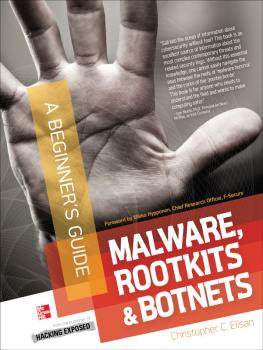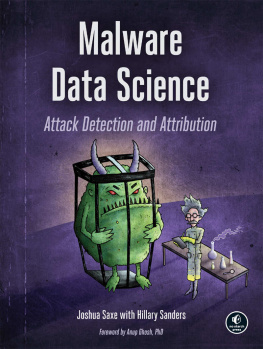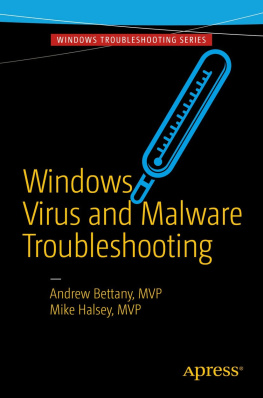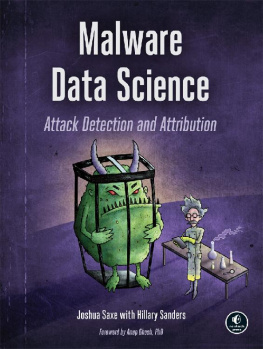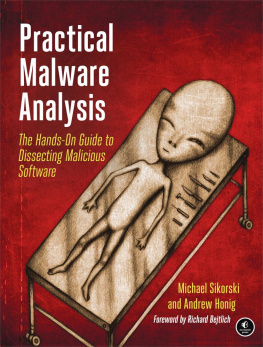Malware, Rootkits & Botnets is a great inspiration for a world under the great pressure of cyber attack. This is a guideline for all information technology persons to have the understanding of todays threat landscape.
Oscar Chang, Chief Development Officer, Trend Micro, Inc.
As stated in the Art of War by Sun Tzu, if you know your enemies and know yourself, you can win all battles. Christopher Elisans book systematically demystifies the thought process of both of the malware writers and the anti-malware solution providers. Christopher is generous in sharing his security knowledge and experience in this book. He took a hands-on approach in explaining the industry lingo, common practices, the layered approach to malware analysis, and some of the tools and techniques used by both the good guys and the bad guys. Reading this book is how you get to know your enemies and yourself really well. I would characterize this book as compulsory reading material for all the security professionals responsible for securing hosts, applications, or networks from known and unknown security threats.
Chee Tan, Director of Business Development, Avira Inc.
Security is often hard to simplify without sacrificing key points that are critical to the protection of data and systems. Christopher is able to take one of the most complex topics in security and simplify it without sacrifice. This book is a must-read for beginner and advanced users alike.
Richard Kohn, Sr. Services Product Manager, Symantec
A fascinating, deep-dive into the work performed by anti-malware vendors and the daunting challenges they face in the never ending cat-and-mouse game with malware authors. Truly great insight into how pervasive and truly frightening todays malware landscape has become.
David Monaco, Director of Information Security, Radialpoint Inc.
Computers are our day-to-day tools in this information driven world. Be it smartphones, tablets, or laptops, more and more of our lives depend on the safe use of these life enhancing devices. How are we making sure we protect our information? Christopher explains in easy to understand language one of the most exciting fields of IT: the Anti-Virus world. Read this book to understand how to prepare for that fight. Anyone who wants to take responsibility for their own security must read this book.
Vasco Duarte, Agile Coach, Avira Operations GmbH
This is one of the best books on malware today. It explains malware techniques in detail from both sides, attacker and defender, with rich sets of real-world cases. If you are a beginner, this book helps you build a solid knowledge foundation; if you are already a professional, it convinces you that what you have implemented is not good enough and you still have tough challenges ahead; if you are a CIO/IT security manager, it presents you with a clearer picture of why fighting with malware is not easy and why you may have to allocate more budget for it.
Lixin Lu, CTO, validEDGE
Malware, Rootkits & Botnets is a great primer on malware and what you can do to protect yourself and your organization from it. If youve been mystified by or apprehensive about learning all of the lingo, rest assured that this book will clearly explain the basics in a way that will empower you to understand the big picturefrom the sides of both the bad guys and the good guys. And once you do, youll be prepared to evaluate your security posture, recognize possible malware threats, and take action!
Roger Harrison, Senior Director of WebPulse R&D, Blue Coat Systems
If you are joining (or want to learn about) the computer security industry, Malware, Rootkits & Botnets: A Beginners Guide is a must-read to quick start your way into learning all the jargon, concepts, and technologies that comprise the Threat Landscape. It accurately explains the history of malware and the work that goes on inside anti-malware labs in creating solutions against computer threats as they evolved.
Jong Purisima, Antivirus Lab Manager, GFI-VIPRE
Malware, Rootkits & Botnets: A Beginners Guide offers an excellent introduction to the art and science of threat intelligence and malicious code analysis. Chris Elisan offers a real world, pragmatic approach that takes the reader (regardless of his or her experience level) through detailed methodology and examples that are sure to enhance the comprehension and expertise of the reader. As threat campaigns become more prevalent and sophisticatedthreatening an ever increasing number of organizations globallythe ability to understand the threat landscape fluently will become nonnegotiable.
Will Gragido, Sr. Manager, RSA Threat Watch and author of Cyber Crime and Espionage: An Analysis of Subversive Multi-Vector Threats
Fresh and insightful book outlining all the key elements of Malware analysis process today. A must have.
Mario Vuksan, CEO, ReversingLabs
Malware, Rootkits & Botnets
A Beginners Guide
Christopher C. Elisan
New York Chicago San Francisco
Lisbon London Madrid Mexico City
Milan New Delhi San Juan
Seoul Singapore Sydney Toronto
Copyright 2013 by The McGraw-Hill Companies. All rights reserved. Except as permitted under the United States Copyright Act of 1976, no part of this publication may be reproduced or distributed in any form or by any means, or stored in a database or retrieval system, without the prior written permission of the publisher.
ISBN: 978-0-07-179205-9
MHID: 0-07-179205-8
The material in this eBook also appears in the print version of this title: ISBN: 978-0-07-179206-6, MHID: 0-07-179206-6.
McGraw-Hill eBooks are available at special quantity discounts to use as premiums and sales promotions, or for use in corporate training programs. To contact a representative please e-mail us at .
All trademarks are trademarks of their respective owners. Rather than put a trademark symbol after every occurrence of a trademarked name, we use names in an editorial fashion only, and to the benefit of the trademark owner, with no intention of infringement of the trademark. Where such designations appear in this book, they have been printed with initial caps.
Information has been obtained by McGraw-Hill from sources believed to be reliable. However, because of the possibility of human or mechanical error by our sources, McGraw-Hill, or others, McGraw-Hill does not guarantee the accuracy, adequacy, or completeness of any information and is not responsible for any errors or omissions or the results obtained from the use of such information.
TERMS OF USE
This is a copyrighted work and The McGraw-Hill Companies, Inc. (McGraw-Hill) and its licensors reserve all rights in and to the work. Use of this work is subject to these terms. Except as permitted under the Copyright Act of 1976 and the right to store and retrieve one copy of the work, you may not decompile, disassemble, reverse engineer, reproduce, modify, create derivative works based upon, transmit, distribute, disseminate, sell, publish or sublicense the work or any part of it without McGraw-Hills prior consent. You may use the work for your own noncommercial and personal use; any other use of the work is strictly prohibited. Your right to use the work may be terminated if you fail to comply with these terms.
THE WORK IS PROVIDED AS IS. McGRAW-HILL AND ITS LICENSORS MAKE NO GUARANTEES OR WARRANTIES AS TO THE ACCURACY, ADEQUACY OR COMPLETENESS OF OR RESULTS TO BE OBTAINED FROM USING THE WORK, INCLUDING ANY INFORMATION THAT CAN BE ACCESSED THROUGH THE WORK VIA HYPERLINK OR OTHERWISE, AND EXPRESSLY DISCLAIM ANY WARRANTY, EXPRESS OR IMPLIED, INCLUDING BUT NOT LIMITED TO IMPLIED WARRANTIES OF MERCHANTABILITY OR FITNESS FOR A PARTICULAR PURPOSE. McGraw-Hill and its licensors do not warrant or guarantee that the functions contained in the work will meet your requirements or that its operation will be uninterrupted or error free. Neither McGraw-Hill nor its licensors shall be liable to you or anyone else for any inaccuracy, error or omission, regardless of cause, in the work or for any damages resulting therefrom. McGraw-Hill has no responsibility for the content of any information accessed through the work. Under no circumstances shall McGraw-Hill and/or its licensors be liable for any indirect, incidental, special, punitive, consequential or similar damages that result from the use of or inability to use the work, even if any of them has been advised of the possibility of such damages. This limitation of liability shall apply to any claim or cause whatsoever whether such claim or cause arises in contract, tort or otherwise.

